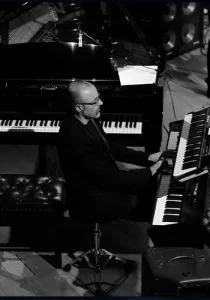General, Piano Technique, Tutorials
 The “Holy Grail” for pianists is to find an “effortless” technique which allows them to be at one with the instrument. This is something that has interested me for the past 20 years and which I believe I’m beginning to gain some understanding of. I’ve been meaning to blog about this for ages but it’s such a huge subject!
The “Holy Grail” for pianists is to find an “effortless” technique which allows them to be at one with the instrument. This is something that has interested me for the past 20 years and which I believe I’m beginning to gain some understanding of. I’ve been meaning to blog about this for ages but it’s such a huge subject!
Most of what’s written below is taken from an email I sent to a colleague regarding piano students and how this may be of benefit to some of the more advanced pianists.
The whole subject of technique is extremely complicated and is not simply understanding the mechanism by which we play the instrument, but relies hugely on how we hear and think about music too.
For me, there is a distinct difference between “technique” and something which I shall call “mechanism”. By “mechanism” I mean an efficient use of the muscles of the hand and arm which allows for “effortless” playing by means of gaining maximum effect with minimum input of energy.
Of course this is “technique”, but that word has other implications such as ability to play thirds, octave passages and other specific technical difficulties which are a different concern. Jazz musicians don’t need to build a formidable “technique” in the same way that a classical musician does but the ability to play accurately with precise rhythm and good tone, without conscious awareness of technique is vital. Although applicable to any good musician, this is a specific area of concern for improvisers because we cannot fall back on knowing the notes .
Any physical discomfort is a barrier to improvisation as we need almost all of our conscious mind devoted to creating the notes in the first place. We also need to learn how to combat unwanted tension.
I once asked a very well respected teacher what one should do if experiencing tension and the reply was “play through it!” which is a familiar response and one I find at best unhelpful and can in extreme cases lead to focal dystonia. Another problem which arises more often with students of Jazz/ improvisation is that they usually come to the piano at a later age and haven’t built up a technique at a time when their hands and wrists are more supple and still growing. As a result, many students play the piano with tension or at the very least a highly inefficient technique which wastes energy and produces a bad tone, usually with muscle stiffness. My own approach is based upon:
Firstly “timing” the key correctly – nothing to do with rhythm, but rather, feeling the point at which the hammer strikes the string so that one can input the minimum required energy to gain the maximum affect.
Maximising the use of the small muscles of the hand (which are very weak but allow great independence) while minimising the work done by the long flexors and extensors which are joined to the forearm. This system of muscles and tendons is very strong and yet impedes finger independence, results in a stiffened wrist, finger insensitivity and can result in pain if overworked. Most students I see (and many professionals) overuse these long flexors and extensors.
For me, the basic piano playing mechanism relies on:
allowing the hand to drop completely -thus allowing a loose wrist and removing unnecessary work from the Flexor Digitorium System in the arm.
For the finger to strike the key (“timing” the key/ hammer precisely)
The finger then supports the weight of the hand (rather like a house resting on stilts).
The fingers do not press at all- they support (they are never passive).
The next key is struck by a finger and the weight of the hand is transferred from the first finger to the next with no break – producing an “effortless” legato.
Additional energy required for most playing can be added by pushing from the arm or adding additional weight from the arm.
The “feeling” of playing a legato phrase is to drop onto the first note, then feel a continuous connection with the keyboard throughout the phrase and finally pick the hand up at the end. Playing is effortless, with a good tone and extremely rapid.Although this sounds simple, most pianists are unable to achieve the correct results due to an overuse of the long flexors. These give the pianist a feeling of strength and security but they also “take over” work that needs to be done by the small, far weaker muscles within the hand. This means that the pianist may look as though he or she is performing the correct action but the work is done by the wrong muscle groups and the correct feeling will not be achieved. Work must e built up from a very small sound, learning to time the hammer precisely and to allow the arm to completely let go of the hand at the wrist. Only then can additional power be added. Obviously this is only part of a comprehensive technique but the “mechanism” is essential. This is a huge subject and one which produces much disagreement among pianists! This is a really an introduction and I’ll be adding to this subject with images and video. I’d love to hear the thoughts of other pianists.

 download jazz harmony pdf
It’s important to be able to instantly recognize these larger intervals in every key as well as to utilize them properly by means of good “voicing”.
To Jazz and commercial musicians “voicing” is the way that one places the notes of the chord across the keyboard (or among the instruments if arranging) and really, is of more importance than the simple choice of notes in the chord.
download jazz harmony pdf
It’s important to be able to instantly recognize these larger intervals in every key as well as to utilize them properly by means of good “voicing”.
To Jazz and commercial musicians “voicing” is the way that one places the notes of the chord across the keyboard (or among the instruments if arranging) and really, is of more importance than the simple choice of notes in the chord.

My own study of piano technique began after my initial rapid progress (from 0 to Grade 8 in 1 year) began to subside and I needed to go back and cover much needed groundwork and really understand how to control the instrument, my muscles and my thoughts! In the following years I came up against various dead ends and numerous technical methods which in my opinion, are flawed. I now possess a reliable technique with a good tone which (on good days) is completely effortless – so that my concentration can be entirely devoted to hearing the music (which is a difficult enough task!)
The article below (re-printed with kind permission) is written by Canadian pianist ALAN FRASER who has developed an approach to technique which I wholeheartedly endorse. His thinking is based upon sound scientific thinking and over 30 years research and performing experience. For further reading and many, many fascinating articles (look out for the one on Horowitz!) please visit: www.alanfraser.net/ www.craftofpiano.com www.maplegroveproductions.com www.pianotechnique.net
The Craft of Piano – an Introduction Why yet another piano method?
Countless excellent methods exist today – but some pianists still fall short of their full potential. Many pianists play with unquestionably beautiful tone and expression, but fewer possess the big, orchestral sound that was the trademark of the Romantic virtuoso. The mark of each artist’s personality is less visible than it was in a bygone era – and there’s a hidden underlying cause: limitations in one’s physical organization.
Craft of Piano also effectively addresses another pressing concern: performance injury.
 What makes this method different?
What makes this method different?
Recent insights into the nature of human movement offer new opportunities for improvement. We know more about how the brain uses the sensory-motor feedback loop to control the muscles and bones, fine-tuning a movement’s accuracy literally dozens of times a second. More is known about the hand’s innate structure, and how its natural grasping function is hidden in virtually all finger actions. Craft of Piano links these developments in kinesiology to piano technique, creating a focus on the physical that enriches personal expression rather than sterilizing it.
What are the basic components of the method?
Instead of defining a particular movement as good or bad, Craft of Piano enriches the sensory picture of your hand, allowing you to find the best way of moving in any pianistic situation. In Craft of Piano, old terms take on new meaning – for instance, relaxation is no longer an end in itself but becomes a means to greater activation of the hand. And new terms are introduced, such as skeletality: how the bones would move if you were a skeleton and nothing more. You learn to make your bones do more of the work, your muscles less. Freed from the need to stiffen or take over the work of the skeleton, your muscles can now fine tune movement, leading to a new level and quality of control – more refined and more powerful.
 Craft of Piano analyses whole body actions such as standing, walking or running, then creates a pianistic analogy to give your hands the sense that they are really starting anew, learning from scratch, with the exciting possibility of leaving old counter-productive habits behind and developing new combinations of grace and power, sensitivity and brilliance.
At the piano we first look at legato, the foundation of piano technique. We discover the structural integrity needed in the hand to create a legato that really joins notes together but avoids stiffening physically – the combination of structural stability and moveability that your hand needs to do the job. We then examine other types of finger action before moving on to the role of the arm in this complex and multifaceted process. Every physical step is linked to listening: to the aural result any particular physical organization will obtain.
Craft of Piano analyses whole body actions such as standing, walking or running, then creates a pianistic analogy to give your hands the sense that they are really starting anew, learning from scratch, with the exciting possibility of leaving old counter-productive habits behind and developing new combinations of grace and power, sensitivity and brilliance.
At the piano we first look at legato, the foundation of piano technique. We discover the structural integrity needed in the hand to create a legato that really joins notes together but avoids stiffening physically – the combination of structural stability and moveability that your hand needs to do the job. We then examine other types of finger action before moving on to the role of the arm in this complex and multifaceted process. Every physical step is linked to listening: to the aural result any particular physical organization will obtain.
How can one put it into practice?
– Learn to sense your own structural power. Lessons in Feldenkrais Method © can help you experience the incredible release of muscular tension that happens when you access the skeletal power of your body.
– Learn how to stand, walk and run skeletally at the keyboard. The Craft of Piano Playing video and book will guide you in developing these qualities in your own playing.
For further reading please visit:
www.alanfraser.net/ www.craftofpiano.com www.maplegroveproductions.com www.pianotechnique.net

